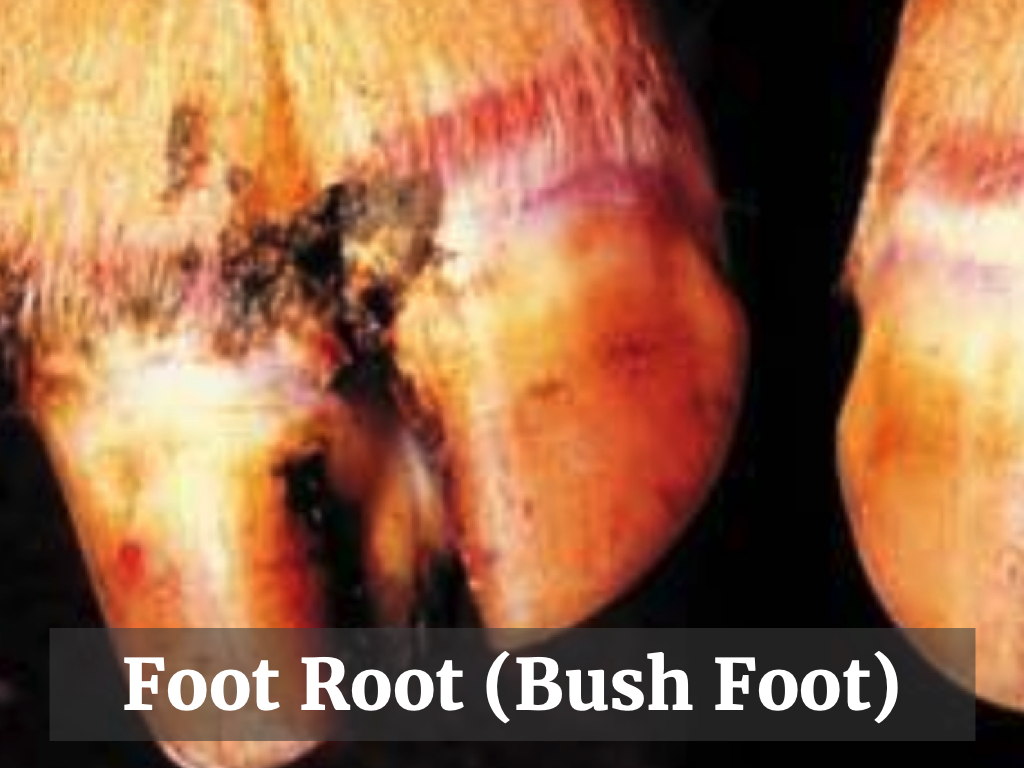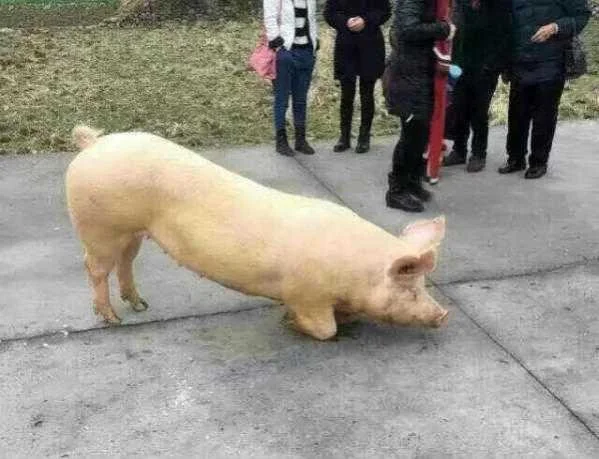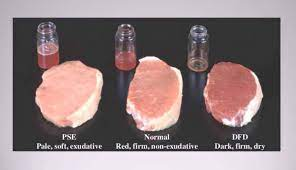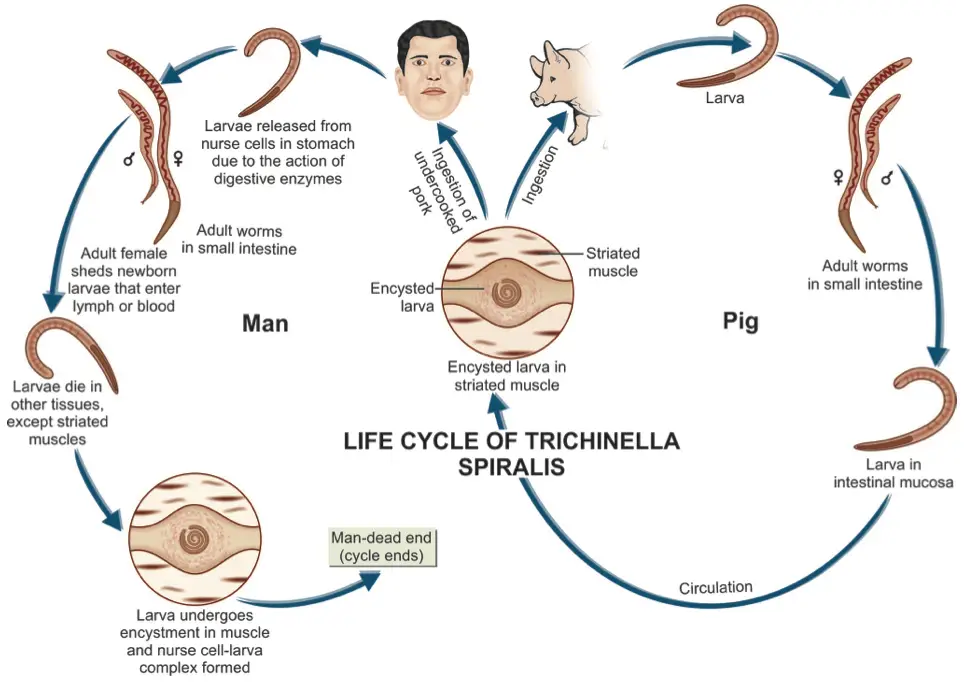22. Diseases of locomotor system in respective pig categories
1/80
Earn XP
Description and Tags
(Diseases of hooves, joints, tendons, Osteochondrosis, Epihysiolysis, disorders of radius & ulna growth, Spondylosis in breeding pigs, Myopathies –splay leg, stress syndrome, NMD; parasites – Sarcocystosis, Cysticercosis, Trichinellosis; Tumours & other diseases associated w/ motion disorders – Myeloma, hypovitaminosis of vit. A, biotin, pantothenic acid....)
Name | Mastery | Learn | Test | Matching | Spaced |
|---|
No study sessions yet.
81 Terms
What are the two main types of diseases of the locomotor system in swine?
Acquired (metabolic, inflammatory, degenerative)
Congenital diseases
Where can pathology be located in swine's locomotor system?
Skin, claw (lamina, corium, capsule), muscle, or bone
What is the second most important reason for culling in swine?
Lameness
What is the purpose of the Swine Locomotion Scoring System?
To assess lameness, detect foot disorders, monitor lameness prevalence, compare incidence between herds, and identify individual sows for functional claw trimming
What should the conditions be like when observing swine for locomotion scoring?
Observations should be made on a flat surface and under non-stressful conditions
What is the scoring for Swine Locomotion Scoring System?
Pig moves easily with little inducement, pig is comfortable on all feet
Pig moves relatively easily, but visible signs of lameness are apparent in at least one leg.
Lameness is involved in one or more limbs. Pig exhibits compensatory behaviours - dipping her head or arching her back
Real reluctance to walk & bear weight on one or more legs. It is difficult to move pig
What are non-infectious causes of locomotor diseases in swine?
Fractures (traumatic, metabolic)
Laminitis
Leg weakness (osteochondrosis)
Muscle tearing
Trauma
Nutritional deficiencies
Porcine stress syndrome
Toxins (ergot)
What are examples of tissue changes that can occur in non-infectious diseases of the swine locomotor system?
Apophyseolysis
Arthritis
Damage to the nervous system
Epiphyseolysis
Fractures
Haematomas
Myositis
Periositis
Osteitis
Osteochondrosis
Osteomalacia
Osteomyelitis
Osteoporosis
What are some infectious causes of locomotor diseases in swine?
Mycoplasma
Brucella spp
Clostridium septicum/perfringens
Chronic erysipelas
Salmonella choleraesuis
Streptococcus suis
Swine vesicular disease
Foot and mouth disease
Sarcocystis
What are examples of diseases of the hoof/claw?
Claw horn overgrowth
Laminitis
Septic laminitis (foot rot/bush foot)
What is the normal growth rate of a claw in swine?
1 cm per month
What nutrients play a role in normal claw growth in swine?
Protein, amino acids (cysteine and methionine), zinc, vitamin D, biotin, and selenium
What can interruptions or surges in nutrient supply cause in swine's claws?
Erratic horn deposition
What is claw horn overgrowth and its impact on swine?
It leads to altered gait and increased strain on joints
Cracks and defects, which can result in sepsis from secondary infections like bush rot
What is the treatment and prevention for claw horn overgrowth in swine?
Claw trimming
What is laminitis in swine?
Inflammation of the sensitive tissue connecting the bone to the hoof (digital laminae)
What is a common clinical sign of laminitis in swine?
Knee-walking, reluctance to stand, lameness, pain over hooves, and warm hooves
How is laminitis in swine diagnosed?
Clinical signs
What is the treatment for laminitis in swine?
Ice, heat, NSAIDs, and euthanasia
What is septic laminitis and its two forms in swine?
Bush foot (infection through sole or claw penetration)
Foot rot (infection progressing to soft tissue between claws)

What bacteria are commonly involved in septic laminitis in swine?
Fusiform bacteria, including E. coli and others (Staph, Strep) found in manure and the environment.
Fusobacterium necrophorum
Dichelobacter nodosus
What is the pathogenesis of septic laminits?
Cracks/openings in foot in dirty environment → contamination of inner part of hoof with bacteria → abscess → abscess swell and burst above and around hoof → swollen foot with dry abscesses and bloody ulcers
What are the clinical signs of septic laminits?
Painful/swollen claw. Affected sows often remain lame, do not eat properly & are usually culled
How is septic laminitis diagnosed?
Clinical sign, exam when animal is recumbent
What is the treatment for septic laminits?
Antibiotics (linomycin, amoxicillin, tetracycline) daily for 5-7 (up to 21) days. Also, topical ATB spray
Anti-inflammatory (ketoprofen, cortisone, dexamethasone)
Herd (formalin 1%, 5% CuSO4)
Clean environment
Severe: flush, debridement, amputation (anaesthesia)
What are common management practices to prevent foot infections in swine?
Good walking surfaces, rubber mats, straw bedding, biotin diets, and proper cleaning and disinfection
What is the common outcome for sows with severe cases of septic laminitis?
They often remain lame, do not eat properly, and are usually culled
What are examples of diseases of joints and bones?
Fractures
Osteochondrosis
What is the aetiology of fractures in swine?
Uncommon. Trauma & fighting although spontaneous ones occur in bone disease such as osteomalacia & osteochondrosis
What are the clinical signs of joint and bone fractures in swine?
Sudden lameness, swollen and painful leg, crepitus, and dog sitting position
How are fractures diagnosed in swine?
History, symptoms & palpation to detect crepitus
What is the typical treatment for fractures in swine?
The affected pig should be slaughtered on the farm
What is osteochondrosis in swine?
A non-infectious condition involving general degeneration of cartilage
Which bones are most commonly affected by osteochondrosis?
Humerus, femur, ribs, lumbar vertebrae
What are the factors contributing to osteochondrosis in swine?
Rapid muscle growth without fast cartilage growth, environmental factors (design of slats), inactivity, high vitamin A, high stocking density, trauma, and rapid weight gain
What are the acute and chronic stages of osteochondrosis?
Acute stage: separation of femoral head (epiphysiolysis), crepitus, fracture, pain;
Chronic stage: abnormal leg conformation, bending and deformity of long bones

What are the clinical signs of osteochondrosis in swine?
Lameness, walking on knees with flexed carpi, over-extended fetlocks, turned-in toes, wide hind leg stance, ataxia, swaying gait, difficulty rising, knock-kneed, and possible spondylosis in breeding pigs

How is osteochondrosis diagnosed?
Clinical signs, post mortem
What is the treatment for osteochondrosis in swine?
There is no treatment, only prevention
What are examples of diseases of muscles?
Porcine Stress Syndrome (PSS)
Splayleg
What is porcine stress syndrome (PSS)?
An inherited condition that includes various forms of exercise-related myopathies induced by stressors in pigs
How is susceptibility to PSS inherited in pigs?
As a single recessive gene (Hal-gen) along with other genes affecting muscle characteristics and halothane sensitivity
What is the pathogenesis of PSS?
Stressors such as transport, mixing, and environmental changes → production of catecholamines → increased blood pressure, tachycardia, tachypnoea, hyperthermia, hyperglycaemia, and muscle cell injury
What are the types of PSS?
Malignant hyperthermia
Acute back necrosis
Pale, soft, exudative pork syndrome (PSE)
Dark, firm, dry pork syndrome (DFD)
Acute stress-induced heart failure
What is malignant hyperthermia in pigs?
A drug-induced stress syndrome occurring within three minutes after inhalation of halothane and oxygen, causing muscle tremors, rapid respiration, and hyperthermia
What are the clinical signs of malignant hyperthermia in pigs?
Sudden onset of muscle tremors, twitching of the face, rapid respiration, red and blotched skin, death within 15-20 minutes, rigor mortis within 5 minutes of death, hyperthermia over 41°C
What is acute back necrosis in pigs?
A condition where pigs, particularly the German landrace, produce excessive catecholamines leading to hyperthermia, lactic acid production, muscle pain, swelling, and atrophy (m. longissimus dorsi)
What are the clinical signs of acute back necrosis in pigs?
Severe lumbar muscle pain, muscle swelling, incoordination, necrosis, haemorrhages, lameness, reluctance to stand, dog-sitting position, skin discoloration, and death within 1-2 days
What are the post-mortem findings of acute back necrosis in pigs?
Early rigor mortis, incomplete bleeding, and petechial dystrophic changes in the affected muscle
How is acute back necrosis diagnosed?
Clinical signs, post mortem, increased CPK, LDH, ALD
What causes pale, soft, and exudative (PSE) pork syndrome in pigs?
Increased catecholamine production during stress before slaughter, leading to hyperthermia (no water binding) and increased glycogenolysis (increase lactic acid production)
Which breeds are susceptible to PSE?
Pietran, Landrace
Which muscles are primarily affected by PSE?
m. longissimus dorsi
m. semimembranosus
What are the characteristics of PSE pork?
Pale colour, soft consistency, dropsy, low water-binding capacity
How is PSE diagnosed in pigs?
By measuring the final meat pH (5.4-5.8) one hour post-slaughter and observing the colour and consistency of the meat
What is dark, firm, and dry (DFD) pork syndrome in pigs?
A condition resulting from prolonged transport and starvation before slaughter, leading to high pH and dark red, sticky meat
What are the clinical signs of DFD syndrome in pigs?
Anxiety, muscle or tail tremor, skin blushing, open-mouthed breathing, collapse, and death
What are the post-mortem findings of DFD syndrome in pigs?
Dark red, dry, firm meat and visceral congestion. Within 45 mins, pH = 6.4

What is acute stress-induced heart failure in pigs?
A condition where catecholamines cause rapid collapse and death within 4-6 minutes, along with dyspnoea, cyanosis, tachycardia, arrhythmia, and increased muscle metabolism
What is splayleg in pigs?
A condition where newborn piglets cannot hold their front and/or hind legs together, impairing mobility and teat access
What causes splayleg in piglets?
Immaturity of muscle fibres in the hind legs and over the pelvis, as well as choline deficiency in the sow
What are the clinical signs of splayleg in piglets?
Unable to stand with hind legs deflected laterally, often adopting a dog-sitting position
What is the treatment for splayleg in piglets?
Taping the hind legs together with a 25mm wide elastoplast, ensuring a 50-80mm gap, and using massage and assisted feeding
What are examples of nutritional diseases affecting the locomotor system?
Disorders of calcium and phosphorus metabolism
White muscle disease
What are examples of disorders of calcium and phosphorus metabolism?
Rickets
Osteomalacia
Osteodystrophia fibrosa
Osteoporosis
Puerperal tetany
What is white muscle disease (WMD) in pigs?
A condition caused by vitamin E and/or selenium deficiency, more common in lambs, calves, and chickens than in swine
What are the clinical signs of white muscle disease in pigs?
Muscle degeneration, acute heart arrest, inability to stand, stiffness, trembling, weakness, and infertility
What are the post-mortem findings of white muscle disease in pigs?
Pallor or streaks of white, gritty mineralisation in skeletal muscles, especially in the longissimus dorsi, and characteristic necrosis or mineralisation of individual muscle fibres
What are examples of infectious diseases affecting the locomotor system?
Cysticercosis
Trichinellosis
What is cysticercosis in pigs?
An infection caused by Taenia solium (pork tapeworm; Cysticercus solium; ZOONOTIC) or Taenia hydatigena (Cysticercus tenuicollis)
What is the life cycle of Taenia solium in pigs?
A diheteroxenous life cycle with humans as the definitive host and pigs as intermediate hosts, where larvae penetrate the intestinal wall and develop in muscles as cysts (Cysticercus cellulosae)
What is the pathogenesis of cysticercosis in swine?
Metacestodes located in muscles of sacrum, shoulder blade, diaphragm and tongue
What are the clinical signs of cysticercosis in pigs?
Generally not observed but can include respiratory disorders, stiff gait, difficulties with food intake, and nervous disorders
What are the post mortem lesions of cysticerosis in swine?
Pearly white, 10mm cysts in striated muscle, tongue, heart, brain
What is the diagnosis for cysticercosis?
Human (DH): recovery of gravid proglottids
Pigs (IH): Post mortem findings, ELISA, PCR
What is the treatment for cysticercosis?
Praziquantel, espirantel, albendazole, fenbendazole, niclosamide, vaccination in development
What is the prevention against cysticercosis?
Prevent access to eggs, food containment – no access w/ FH, human hygiene, sufficient cooking of meat, regular worming of FH
What is trichinellosis in pigs?
A disease caused by Trichinella spp., which can be capsule-forming (e.g., T. spiralis, britovi, nativa) or non-capsule forming (e.g., T. pseudospiralis)
What is the life cycle of Trichinella spp. in pigs?
Pigs act as both the final and intermediate host.
Adult worms inhabit the small intestine where females release L1 (viviparous), which are distributed via blood & lymph vessels & infect striated muscle cells where they form cyst (infectious stage)

What are the clinical signs of trichinellosis in pigs?
Asymptomatic infections are common but severe cases may include catarrhal enteritis, diarrhoea, vomiting, myositis, stiffness, pain, restlessness, convulsions, oedema, heart dysfunction, and difficulty swallowing
What is the diagnosis for trinchinellosis?
Digestive method with magnetic stirrer or latex agglutination. Trichinoscopy possible but not mandatory in EU.